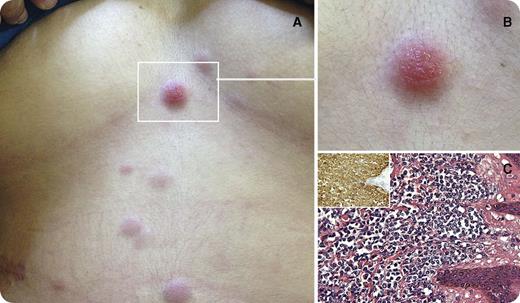A 27-year-old woman presented with dermal nodules on the scalp, abdomen (panels A-B), breast, and genitalia. An abdominal skin biopsy showed a population of immature cells (panel C; original magnification ×100; hematoxylin and eosin stain) positive for CD45/LCA, CD43, CD68 (panel C inset; original magnification ×100; immunoperoxidase stain), CD163, myeloperoxidase (focal), and Ki-67 (∼60%) and negative for other markers tested, supporting the diagnosis of myeloid sarcoma. Complete blood count and bone marrow examination subsequently showed acute monoblastic leukemia; conventional cytogenetics were normal and NPM1 mutation was present. The patient received chemotherapy and underwent complete remission.
Myeloid sarcoma is a tumor mass of myeloid cells that involves an extramedullary site. The clinical history in patients with myeloid sarcoma is highly variable. Most often, myeloid sarcoma occurs in patients with simultaneous bone marrow involvement or as a relapse of acute myeloid leukemia. Myeloid sarcoma can occur as blastic transformation in patients with a myelodysplastic syndrome (MDS), myeloproliferative neoplasm (MPN), or MDS/MPN. Myeloid sarcoma also may develop in cancer patients treated previously with chemotherapy and in this context might be secondary to therapy. In a minority of patients, myeloid sarcoma can be an initial manifestation of disease. Myeloid sarcoma can appear at any age and involve virtually any anatomic site.
A 27-year-old woman presented with dermal nodules on the scalp, abdomen (panels A-B), breast, and genitalia. An abdominal skin biopsy showed a population of immature cells (panel C; original magnification ×100; hematoxylin and eosin stain) positive for CD45/LCA, CD43, CD68 (panel C inset; original magnification ×100; immunoperoxidase stain), CD163, myeloperoxidase (focal), and Ki-67 (∼60%) and negative for other markers tested, supporting the diagnosis of myeloid sarcoma. Complete blood count and bone marrow examination subsequently showed acute monoblastic leukemia; conventional cytogenetics were normal and NPM1 mutation was present. The patient received chemotherapy and underwent complete remission.
Myeloid sarcoma is a tumor mass of myeloid cells that involves an extramedullary site. The clinical history in patients with myeloid sarcoma is highly variable. Most often, myeloid sarcoma occurs in patients with simultaneous bone marrow involvement or as a relapse of acute myeloid leukemia. Myeloid sarcoma can occur as blastic transformation in patients with a myelodysplastic syndrome (MDS), myeloproliferative neoplasm (MPN), or MDS/MPN. Myeloid sarcoma also may develop in cancer patients treated previously with chemotherapy and in this context might be secondary to therapy. In a minority of patients, myeloid sarcoma can be an initial manifestation of disease. Myeloid sarcoma can appear at any age and involve virtually any anatomic site.
For additional images, visit the ASH IMAGE BANK, a reference and teaching tool that is continually updated with new atlas and case study images. For more information visit http://imagebank.hematology.org.


